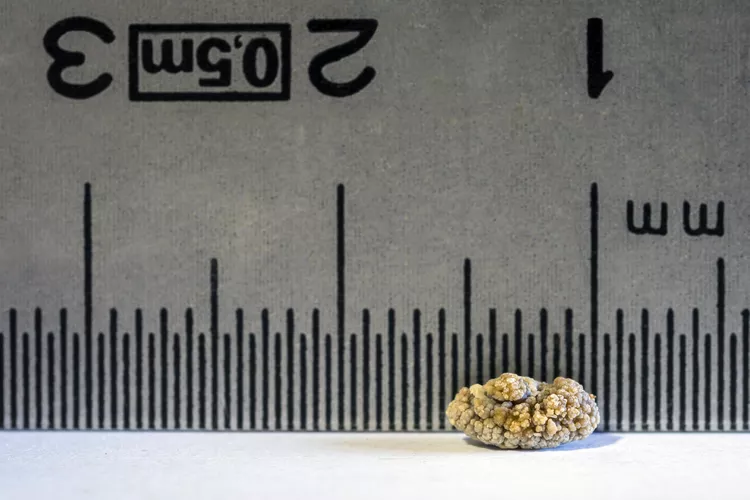Kidney stones are those pesky little hard deposits made up of minerals and salts that form in your kidneys. How they’re treated really depends on their size, where they’re located, and the symptoms they cause.
In this article, we’re zooming in on kidney stones that are between 1 mm and 3 mm in size. We’ll explore whether these tiny stones can pass on their own. We’ll also discuss when it’s time to seek medical help. Additionally, we’ll examine what their size really means for your everyday life.
What Does a 1 mm to 3 mm Kidney Stone Look Like?
- A kidney stone that’s 1 mm or 2 mm is often likened to a grain of sand.
- The 2 mm stone is so small. It’s almost like a pinhead. You might not even notice it unless it starts causing some discomfort or pain.
- A 3 mm stone is still on the smaller side. However, it can still lead to ureteral blockage or pain. This depends on where it’s sitting.
These sizes are pretty typical for the early stages of kidney stone development.
2mm Kidney Stone Actual Size: Will It Pass?
A 2mm kidney stone actual size is comparable to a small grain of sand. Most stones this size may pass naturally with hydration and supportive care. However, pain, frequency of urination, and mild hematuria (blood in urine) may still be present during passage.
3mm Kidney Stone Size: What to Expect?
The 3mm stone size is just on the borderline. Some 3 mm stones may pass naturally with increased fluid intake and medical observation. However, their passage can still be painful.
Tips to Help Pass a 1 mm to 3 mm Kidney Stone Naturally:
- Drink at least 2.5 to 3 liters of water daily
- Avoid salty foods and oxalate-rich items like spinach, beets, and chocolate
- Take prescribed alpha-blockers to relax the ureter
- Regular follow-up with a urologist to monitor stone movement
Kidney Stone Size and Treatment Options (1–3 mm)
For stones within the kidney stone size range of 1 mm to 3 mm, treatment is usually conservative. However, if the stone is stuck or causing severe symptoms, medical intervention might be required.
Common Treatment Approaches:
- Watchful Waiting: For stones ≤3 mm, especially when asymptomatic
- Medical Expulsive Therapy: Includes alpha-blockers to assist passage
- Pain Management: NSAIDs or mild opioids to relieve symptoms
- Surgical Options (rare at this size):
- May be considered if stone causes recurrent infections or does not pass in weeks
- Lithotripsy size of stone generally starts at ≥5 mm, but may be used if clinically justified
FAQs around 1mm -3mm Kidney Stones
Q1. What’s the typical size of a kidney stone in millimeters?
A: Generally, kidney stones that can pass on their own are between 1 mm and 4 mm in size. If they’re larger than that, you’ll likely need some medical or surgical assistance.
Q2. Which size of kidney stone is considered dangerous?
A: Stones that are larger than 6 mm are often seen as dangerous. They usually won’t pass naturally. They can lead to serious blockages and kidney damage.
Q3. When does a kidney stone require surgery?
A: According to the kidney stone size chart, stones that are 5 mm or larger may need surgical intervention. A 5 mm pathri is an example. This includes procedures such as lithotripsy or ureteroscopy. This is especially true if they’re causing symptoms or are stuck.
Q4. What’s the average size of a kidney?
A: In adults, the average kidney measures about 10 to 12 cm in length. This size is important for imaging assessments, even though it doesn’t relate to the causes of small kidney sizes.
How can you reduce the size of kidney stones?
- Drink plenty of water
- Cut back on salt, sugar, and animal protein
- Enjoy citrate-rich drinks (like lemon water)
- Follow your doctor’s medication advice
Note: While stones usually don’t shrink, taking preventive measures can help stop them from growing or forming new ones.
Summary
Kidney stones measuring 1 mm to 3 mm are small and often pass naturally, especially if you stay well-hydrated.
Stones that are 2 mm and 3 mm can typically be managed with conservative treatment.
To know your kidney stone size in mm, get imaging done and consult your doctor for a personalized treatment plan.
Regular check-ups and lifestyle adjustments can help prevent complications.
Disclaimer:
This content is meant for informational purposes only and should not replace professional medical advice. Always reach out to a urologist or healthcare provider for diagnosis and treatment recommendations.
Also Read – Kidney Transplant Success Rate in India

